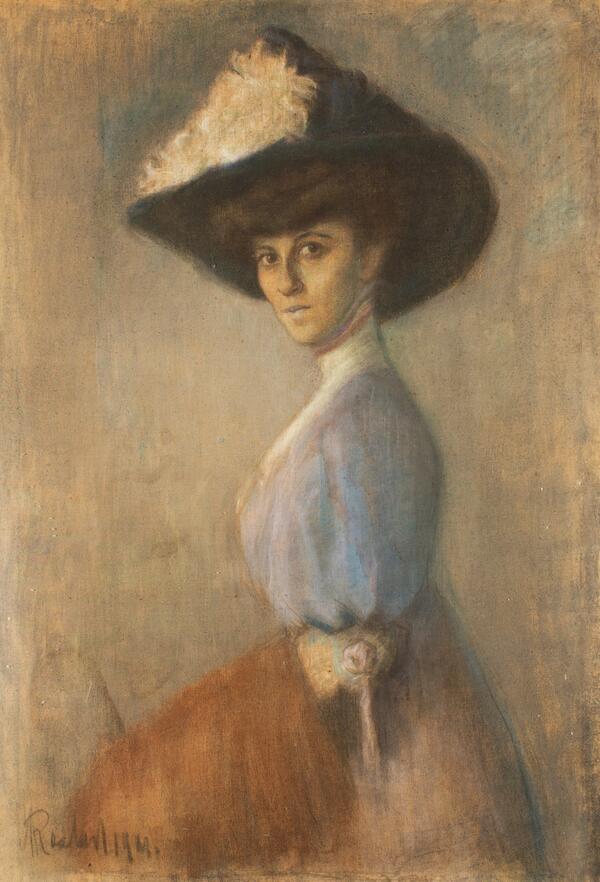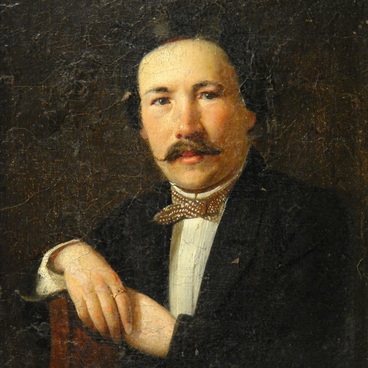Portrait of Sophia Fedorchenko (1880-1959) is the depiction of the wife of Nikolai Rakitsky (1888-1979), a Soviet scientist and agronomist, whose collection formed the basis of the Tarusa Art Gallery collection.
During the First World War, Fedorchenko served as a sister of mercy at the front. In her first book, ‘People at War: Frontline Records’, 1917, she presented short stories and reflections of soldiers about the war, about themselves, and about enemies, adding such elements of soldier’s folklore as songs about war and ditties.
The second part of the book was published in 1925, and the third was published in fragments in magazines in 1927. Her work was received with enthusiasm not only by readers, but also by writers and literary critics such as Maximilian Voloshin, Maxim Gorky, and Alexander Blok. The Bolshevik critic Alexander Voronsky in his article called Fedorchenko’s book ‘a striking artistic document of the era.’ All positive reviews noted the high artistic qualities of the book and the talent of the writer. Nevertheless, when in 1927 she admitted that she did not write down the statements of the soldiers from memory, but was a full-fledged author of the book. A flurry of criticism fell upon her, primarily from the writer Demyan Bedny.
Despite the emotional shock of the attacks, Fedorchenko continued her literary career and devoted herself to children’s literature. She created children’s books, wrote riddles and amusing stories. In the 1950s – 1960s, she created the novel-trilogy ‘Pavel Semigorov’, which tells about life during the Pugachev era.
Since 1926, the couple settled in Tarusa. Around his own house, Rakitskiy created an arboretum garden with acclimatized trees and shrubs.
The author of Fedorchenko’s portrait from the gallery’s collection wasn’t identified, only his surname Kozlov is known. In the portrait, the model is shown almost in full growth, the face is deployed in three quarters, and the figure is presented in profile. The artist pays special attention to the reproduction of her exquisite dress: a wide-brimmed hat decorated with white ostrich feathers, muffs, sleeve decor, color combination of garments. A delicate muted color scheme, recreated in pastel technique, is used. The features of the heroine’s face are expressively traced, her deep intelligent look, somewhat inflamed, is reflected. The writer suffered from neurasthenia and in 1925 she was consulted by Mikhail Bulgakov. This portrait embodies the features characteristic of a portrait of the Art Nouveau era, associated with the graphics of Lev Bakst and Valentin Serov of the same period.
During the First World War, Fedorchenko served as a sister of mercy at the front. In her first book, ‘People at War: Frontline Records’, 1917, she presented short stories and reflections of soldiers about the war, about themselves, and about enemies, adding such elements of soldier’s folklore as songs about war and ditties.
The second part of the book was published in 1925, and the third was published in fragments in magazines in 1927. Her work was received with enthusiasm not only by readers, but also by writers and literary critics such as Maximilian Voloshin, Maxim Gorky, and Alexander Blok. The Bolshevik critic Alexander Voronsky in his article called Fedorchenko’s book ‘a striking artistic document of the era.’ All positive reviews noted the high artistic qualities of the book and the talent of the writer. Nevertheless, when in 1927 she admitted that she did not write down the statements of the soldiers from memory, but was a full-fledged author of the book. A flurry of criticism fell upon her, primarily from the writer Demyan Bedny.
Despite the emotional shock of the attacks, Fedorchenko continued her literary career and devoted herself to children’s literature. She created children’s books, wrote riddles and amusing stories. In the 1950s – 1960s, she created the novel-trilogy ‘Pavel Semigorov’, which tells about life during the Pugachev era.
Since 1926, the couple settled in Tarusa. Around his own house, Rakitskiy created an arboretum garden with acclimatized trees and shrubs.
The author of Fedorchenko’s portrait from the gallery’s collection wasn’t identified, only his surname Kozlov is known. In the portrait, the model is shown almost in full growth, the face is deployed in three quarters, and the figure is presented in profile. The artist pays special attention to the reproduction of her exquisite dress: a wide-brimmed hat decorated with white ostrich feathers, muffs, sleeve decor, color combination of garments. A delicate muted color scheme, recreated in pastel technique, is used. The features of the heroine’s face are expressively traced, her deep intelligent look, somewhat inflamed, is reflected. The writer suffered from neurasthenia and in 1925 she was consulted by Mikhail Bulgakov. This portrait embodies the features characteristic of a portrait of the Art Nouveau era, associated with the graphics of Lev Bakst and Valentin Serov of the same period.



